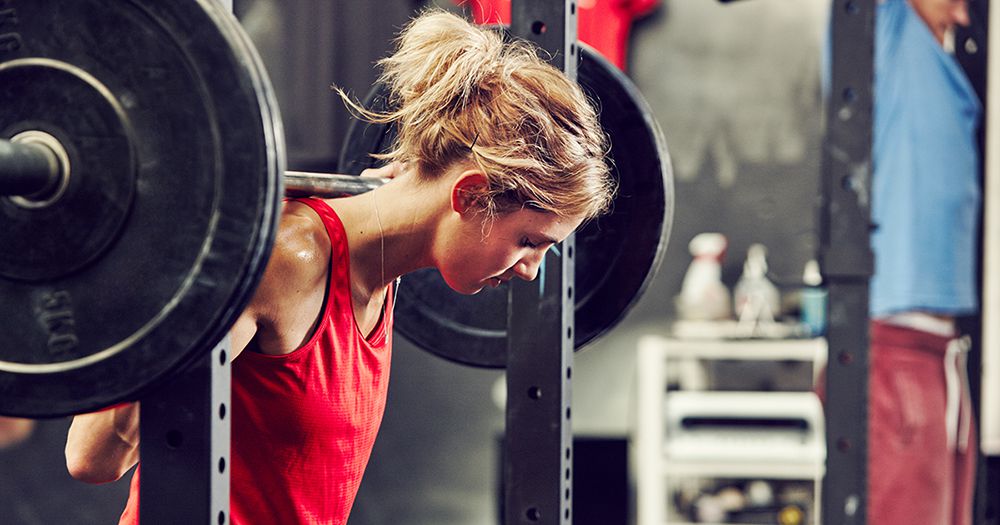
When starting any new fitness routine, you want to ease into the movements to perfect your form, avoid injury, and, ultimately, get the best results. This is especially true when it comes to high-intensity training such as CrossFit.
Heading into your first box or CrossFit WOD is a bit different from any boot-camp class you’d try at your local gym-the strength training and plyometric moves involved are complex and require precise form and familiarity. Winging it isn’t really a viable option if you want to avoid injury.
This isn't to say you should be scared to try something hard or something new; quite the opposite, in fact. But learning about the common CrossFit mistakes most beginners will make can at least help you feel more comfortable with what to expect on day one.
Here, CrossFit trainers share common mishaps when starting a CrossFit program, as well as a few safety tips. Once you've got the basics down, don't be surprised if you're hooked on this heavy-lifting style of training.
Crossfit Mistake #1: Bad Form
There are lots of exercise names thrown around CrossFit rooms (or written on a chalkboard). This can be confusing and intimidating for newbies, says Melody Sanchez, an instructor at Brick in NYC, since you might not know what certain exercises mean. For instance, what’s a goblet squat? Experienced CrossFitters might be able to jump right in, but that’s a dangerous idea for beginners.
Ask for help. There's no shame in telling the instructor you're new to this. Heck, you're out there trying to get strong with the rest of them. Any box will have a skilled instructor who can break down proper form for you to ensure you're safe. If he or she doesn't immediately ask if there are rookies in class, just make your presence known.
Two exercises a lot of CrossFit beginners get wrong: The air squat and the deadlift, says Sanchez. And these two power moves are important to get down as they are “basic foundational movements of any weighted or other complex movements” you could do later in class.
How to do a proper air squat: Stand with feet hip-width apart and toes turned out slightly. With weight in your heels and chest lifted, bend knees and squat low and keep knees behind toes. Press up through heels and squeeze glutes to come to standing.
How to do a proper deadlift: With feet slightly less than hip-width apart, holding weight in both hands, slowly hinge at the hips and lower weight straight down in front of your shins. Keep back straight, careful not to arch or round. Push through heels and squeeze glutes to come to standing.
What’s more, new (and sometimes even seasoned) CrossFitters alike will end up sacrificing form for reps, trying to do too much before they’re ready, says Todd Nief, owner and lead trainer at South Loop Strength & Conditioning, a CrossFit studio in Chicago. Beginners tend to go all-out too quickly, where “they might be willing to let their technique go to do a workout faster or to get more reps done in a specific time frame,” he says. This is where mistakes are made and injuries happen.
Bottom line: It's not your fault if you have bad form in the beginning, but it's on you to ask the instructor to show you proper form. Get the form down pat from the beginning, and you'll be able to safely grow as an athlete from there.
CrossFit Mistake #2: Not Pacing Yourself
When new to CrossFit, "many people have a poor understanding of how to pace themselves in challenging conditioning workouts and hit a point of global fatigue relatively early in a workout," says Nief.
"If you have 20 minutes of intervals and you go out way too hot, you may find yourself barely able to hold it together five minutes in," he says. If you give it everything you've got in round 1, every subsequent round is going to feel impossible.
The goal of a training session like that is to find an uncomfortable but sustainable pace, he says. So, "someone with a poor understanding of their own pacing may go out and row at a 1:45/500m pace for their first minute of rowing, and then do 20 burpees in their first minute." (FYI, that's a really fast rowing time, and a LOT of burpees.) If you hit the ground sprinting, by the time you get to the end of an interval, your muscles and endurance will start to fail, and with it, your form. When your form goes rogue, overcompensating for weak, tired muscles can set you up for injuries.
Learn how to properly pace yourself by maintaining the same reps to time ratio with perfect form, suggests Nief. As your endurance and strength progress, you can work your way up to using proper form with higher reps.
CrossFit Mistake #3: Being Hyper Competitive
There's no denying it: CrossFit can fuel your competitive drive, which is okay to an extent because competition can be motivating. Of course, support and camaraderie exist in the box, but the high energy level and stats written next to names on a whiteboard (275-pound back squat?!) can make it easy as a newcomer to compare yourself with more experienced heavy lifters or even CrossFit Games hopefuls in the room.
"More often than not, the newcomer tends to compare themselves to the person next to them," says Sanchez. This interferes with the "slow and steady" mindset. "You might feel pressured to pick up the same weight because you don't want to be viewed as the weak link in the class," she says. But the reality is no one cares-everyone is competing against themselves.
Instead, go with your gut instinct. If a weight feels too heavy, drop it (gently), and choose something more in your range. Keep track of your progress, and over time, you’ll see how you can successfully and safely work your way up. (Here’s a guide for picking the right weights for your workouts.)
CrossFit Mistake #4: Drastically Changing Your Diet
Let's be honest: CrossFit is not usually for the casual exerciser, so it's likely that you're looking for a performance boost, a fitness challenge, or a body composition change if you're signing up. But if you get caught up in the promises of a hard a** and chiseled abs, you might think that you need to go all in-with your workouts and with your eating.
“Many people who are new to a program like CrossFit get excited and they want everything quickly. They want results. They want to compete with the people in classes who have been training for years,” says Nief. To get there, you might be compelled to jump on the latest diet (such as the keto diet or counting macros or IIFYM just because that’s what your new CrossFit friends do. While these restrictive diets can have their benefits for health and performance, they aren’t for everyone or every CrossFit athlete, and they can be tough to implement in the real world, says Nief.
When it comes to training and getting results, it's really about finding a balanced diet that provides energy and nutrition to crush your workouts and refuel and recover afterward. It can be as simple as that.
CrossFit Mistake #5: Not Being Consistent
While you know that consistency is key to seeing results, having trouble sticking to a new workout routine or maintaining your motivation when things get tough is a totally valid and real thing that even the most experienced athletes know a lot about. And LBH, CrossFit has a learning curve-from the lingo to the lifting-there’s a lot thrown at you as a newbie. But staying on track is crucial for CrossFitters who really want to advance their practice and see those 1 rep max numbers go up.
Find a box buddy or mentor who can help keep you accountable and sign up for those early morning classes with you. When work, life, travel, and DOMS get in your way, you'll have each other pushing you to stay strong and committed. Give it a few months: If you're officially a WOD junkie, awesome, but if you gave it your all and realize CrossFit just isn't for you, that's A-OK, too. When fitness is fun, you're more likely to want to exercise. Finding what works and what doesn't is part of the process.














































